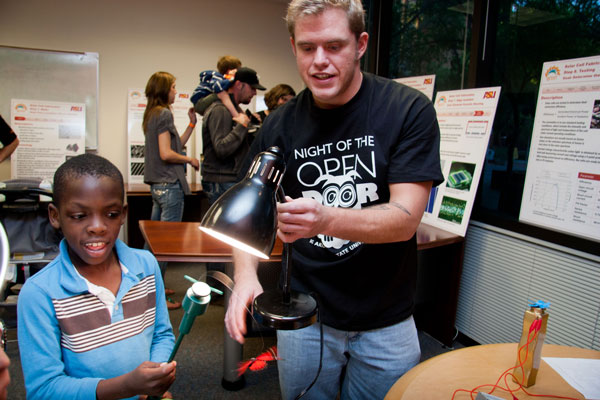
Engineering attractions helped illuminate ASU’s Night of the Open Door

Isaiah Vega participates in a demonstration of electromagnetism at the “Science is Fun” station during the Night of the Open Door. He was one of hundreds of youngsters who took part in interactive displays of energy-generation technologies, biomedical research and the wonders of chemistry, among many other science and engineering presentations. Photo by ASU/Rosie Gochnour
Engineering displays and interactive demonstrations proved especially attractive to youngsters among the more than 2,500 people who came to Night of the Open Door at Arizona State University.
The Saturday evening event on March 3, 2012, at ASU’s Tempe campus showcased a broad sampling of the education and research endeavors that are motivating university students and faculty to pursue innovation in everything from the arts and humanities, to engineering, science and environmental sustainability.
ASU’s Ira A. Fulton Schools of Engineering, College of Liberal Arts and Science, Herberger Institute for Design and the Arts, and the Biodesign Institute combined forces to present more than 100 exhibits, performances, presentations and hands-on learning experiences.
In the engineering realm, visitors got a look at the advances in renewable-energy research being made By ASU’s Solar Power Lab and the Quantum Energy and Sustainable Solar Technology center—along with small-scale demonstrations of solar cells at work.
Engineering students and faculty guided visitors through hands-on learning about wind power technology, roller-coaster car design and the super powers of computing.
Engineering students were also part of the Digital Culture Festival, which explored the melding of arts, media and engineering in development of cutting-edge video, audio, graphics and animation technologies.
Each of the attractions enthralled children and teens throughout an energizing Night of the Open Door.

Six-year-old Naomi Shrader shows a bag full of informational materials about solar energy that she collected at the Quantum Energy and Sustainable Solar Technologies engineering research center exhibit during the Night of the Open Door. Photo by ASU/Rosie Gochnour

Eight-year-old Linus Ros pieces together a small roller-coaster cart used in an engineering design demonstration at the eSpace studio during Night of the Open Door. Photo by ASU/Rosie Gochnour

ASU electrical engineering student Guy Pickett shows seven-year-old Teles Kamgaing how the power of light can be used to move the blades of a small propeller. Photo by ASU/Rosie Gochnour

Eighteen-month-old Micah Rodriguez (with sister Kay, 6, and brother Alex, 3) reaches out to touch a model airplane powered by energy produced by light. It was one of the demonstrations of solar cells presented by the Quantum Energy and Sustainable Solar Technologies (QESST) engineering research center at ASU during the Night of the Open door event. Photo by ASU/Rosie Gochnour

Nine-year-old Hayden Mangan helps Ira A. Fulton Schools of Engineering professor Christiana Honsberg use photovoltaic cells to create an electrical circuit to power small motors. Honsberg is director the Solar Power Lab and the Quantum Energy and Sustainable Solar Technologies (QESST) engineering research center at ASU. Photo by ASU/Rosie Gochnour

Iris Rikakis dances in front of an interactive sensory display that produces varying musical sounds and moving images on a screen in response to body movements. It was one of the attractions of the Digital Cultural Festival featuring work from the School of Arts, Media and Engineering. Photo by Rosie Gochnour

Darian Dixon and his children take a quiz about solar energy at the Quantum Energy and Sustainable Solar Technologies (QESST) engineering research center exhibit at Night of the Open Door. Photo by ASU/Rosie Gochnour

Students in the School of Arts, Media and Engineering participated in the Digital Culture Festival as part of the Night of the Open Door. Costumed “animators,” such as the student pictured here, enticed audience members to participate in interactive demonstrations of video, audio and computer graphics technologies. Photo by ASU/Rosie Gochnour



































